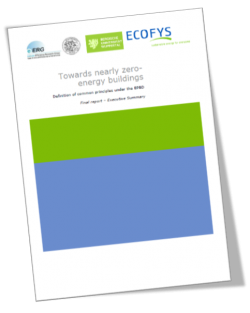Study: Towards nearly zero-energy buildings -Definition of common principles under the EPBD
A consortium led by Ecofys (with eERG Group and University of Wuppertal), undertook a study for the Commission to provide more guidance to Member States and the Commission as regards the implementation of the requirements for nearly zero-energy buildings under the EPBD. The study, which was finalized early in 2013, developed an analytical framework for evaluation the national plans (including a reporting template), identified benchmarks and investigated the convergence between cost optimal levels and nearly zero-energy buildings. Particularly Task 3 (led by the end-use Efficiency Research Group, directed by Prof. Lorenzo Pagliano, in the Politecnico di Milano) aims to develop an explicit methodology for analyzing building variants in terms of energy performance and global costs over 30 years, for detailing the inputs and assumptions of such an analysis and for clearly reporting the results; it also aims to present examples of representative benchmarks for nearly zero-energy building in different European climate regions and based on the results suggest an analytical framework for analyzing national plans.
The study can provide a relevant general framework for developing policy and legislation towards zero energy building also adopting the approach of Passive House strategy with integrated Renewable Energy Systems.
The comprehensive set of requirements of the Passive House standard is already suitable for complete description of high quality nearly Zero Energy Buildings. This is considered also in relevant outcome of this study, particularly for what concerns common principles and indexes for a complete and more precise description of renovations targets and limits toward nZEB levels, eERG-PoliMI proposed more complete indexes for description and ranking of buildings and NZEBs as foreseen by EPBD. This set of indexes, presented below, could describe in quite comprehensive way the building performance in terms of energy efficiency and comfort. These represents also indexes which can be easily and directly understood and interpreted, avoiding or reducing the use of some kind of indirect or normalize indexes, on which we could not have direct references for comparison.
- heating and cooling energy need (which give account of the entity of heat losses/gains via the envelope and ventilation), considering a performance part and a prescriptive part on energy needs and energy uses:
- energy needs for heating, cooling and hot water and energy use for lighting (and optionally energy use for ventilation, auxiliaries and plug loads - this has the advantage of not requiring any weighting factors (performance part);
- additionally, a related prescriptive approach (e.g. U-values for windows and walls, g-values for solar protections, air tightness limits and control tests, (built-in) lighting installations, etc.);
- an index of long term comfort conditions (which gives account of both winter and summer comfort conditions integrating the hourly conditions over the entire year) for instance as indicated in standard EN 15251;
- an index evaluating grid stress induced by temporal mismatch of energy generated onsite or nearby (by RES, high efficient cogeneration, etc.) and building energy demand
- a “load matching index“ or other similar indices in the end showing the share of self-consumed locally generated renewable energy - calculated with time steps of a month , day or (preferably) hour;
- an index based on net yearly primary energy demand.
This kind of approach is already used in the Passive house method, and for instance in legislations adopting it as the related Brussels regulation.
The study “Towards nearly zero-energy buildings -Definition of common principles under the EPBD” is available here on the eERG Group web-site and on the European Commission web site.
